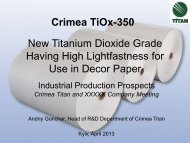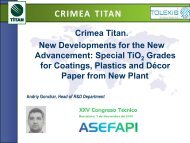Middle East Coating Show 2008 Conference (10 & 11 March 2008)
16:00 – 16:30 Crimea CR-071 – a brand new titanium dioxide grade produced by CJSC «Crimea TITAN». Andriy Gonchar, CJSC Crimea TITAN, Ukraine (Presented by Valentina V. Kosmina) The characteristics of a new titanium dioxide grade developed will be presented and its distinctive aspects in comparison to other CJSC «Crimea TITAN» titanium dioxide grades will be discussed. The application of the new pigment, Crimea CR-071, in various branches of industry will be illustrated.
16:00 – 16:30
Crimea CR-071 – a brand new titanium dioxide grade produced by CJSC «Crimea TITAN».
Andriy Gonchar, CJSC Crimea TITAN, Ukraine
(Presented by Valentina V. Kosmina)
The characteristics of a new titanium dioxide grade developed will be presented and its
distinctive aspects in comparison to other CJSC «Crimea TITAN» titanium dioxide grades
will be discussed. The application of the new pigment, Crimea CR-071, in various
branches of industry will be illustrated.
Create successful ePaper yourself
Turn your PDF publications into a flip-book with our unique Google optimized e-Paper software.
New Materials and Technologies within Organic <strong>Coating</strong>s<br />
DAY 2 | Tuesday, <strong>11</strong> <strong>March</strong> <strong>2008</strong><br />
<strong>10</strong>:00 – <strong>10</strong>:30<br />
Washability and cleanability testing for paint systems<br />
J. F. Fletcher, Elcometer Instruments Ltd, UK (Presented by: C Woolhouse)<br />
The resistance of paint systems to wear caused by repeated cleaning operations and to<br />
penetration of soiling agents is vital for the performance assessment of the paint systems.<br />
Such assessment can be applied to both paint formulation and to paint system selection.<br />
Testing the paints as described in EN ISO <strong>11</strong>998 Determination of wet-scrub and<br />
cleanability of coatings requires that the paint be applied to the substrate under<br />
controlled conditions and then tested using a mechanical wet-scrub apparatus.<br />
This paper describes an automatic film applicator that can be used for preparing suitable<br />
paint samples and a washability tester that meets the requirements of EN ISO <strong>11</strong>998. The<br />
use of thickness measurement, gloss and weight loss as methods of assessing the effect<br />
of the scrub testing will be discussed.<br />
<strong>10</strong>:30 – <strong>11</strong>:00<br />
QUV compared to Xenon Arc<br />
Mark Evans, Q-Lab Europe Limited, UK<br />
Two accelerated weathering test methods: fluorescent ultraviolet and Xenon arc will be<br />
compared. The paper will describe the strengths and limitations for both techniques due<br />
to: simulation of the forces of weathering including sunlight, temperature and moisture,<br />
mounting of test specimens, control of test parameters, and operational considerations.<br />
<strong>11</strong>:00 – <strong>11</strong>:30 Coffee Break<br />
<strong>11</strong>:30 – 12:00<br />
Nanoparticle based UV absorbers for coatings<br />
János Hajas, BYK, Germany<br />
Inorganic metal oxide (ZnO and CeO2) based UV absorbers with very good overall<br />
properties have been developed for aqueous and solventborne coating applications. The<br />
new additives provide significant benefits over “classic” organic UV absorbers and show<br />
excellent properties in wood stains and in architectural paint formulations. Synergistic<br />
effects between nano-zinc oxide and nano-cerium oxide based products will be<br />
highlighted, spectral properties, advantages, disadvantages, side effects and application<br />
results will be discussed in comparison with nano-titanium dioxide and organic UV<br />
absorbers. The new additives are especially recommended for very durable applications in<br />
light coloured stains and clear varnishes, and also in exterior architectural paints.<br />
12:00 – 12:30<br />
Surface morphology and chemistry of epoxy-based coating after exposure to ultraviolet<br />
radiation<br />
Hamad Al-Turaif, King Abdulaziz University, Saudi Arabia<br />
The effect of Ultraviolet (UV) radiation on surface morphology and surface chemistry of<br />
epoxy resin based coating was characterized with both Scanning Electron Microscopy (SEM)<br />
and X-ray Photoelectron Spectroscopy (XPS) which was thoroughly applied to follow the<br />
chemical changes takes place after different UV-exposure periods of time.<br />
SEM images indicated the generation of “silver cracks” on the surface of the coating as a<br />
result of UV-exposure. The shape and width of the cracks are highly related to the UVexposure<br />
period.<br />
XPS revealed that the main carbon peak have an unsymmetrical shape which is due to the<br />
big variety in the type of the carbon bonds in the chemical structure of the epoxy resin.<br />
Evidence of an oxidation degradation process was observed on the coating surface. The<br />
longer the exposure of the coating to UV radiation, the more oxygen bond was formed<br />
causing oxygen content to increase and carbon concentration to decrease. XPS-peak fittings<br />
for four carbon bonds were conducted. Results indicated the cleavage of aliphatic carbonhydrogen<br />
(C-H) and hydroxyl (C-OH) bonds side by side with the formation of carbonyl (C-<br />
OOH) and carboxyl (CO-O) bonds. These changes took place on the surface of the epoxybased<br />
coating. They were discontinued after specific UV-exposure period of time.<br />
12:30 – 14:00 Lunch<br />
14:00 – 14:30<br />
Color Space Concept with interference pigments for coating applications<br />
Matthias R.F. Kuntz, Adalbert Huber, Gerhard Pfaff, Merck KGaA, Germany<br />
A new Color Space Concept for interference pigments will be presented which meets the<br />
desire for new styling possibilities in the areas of color saturation, texture, and improved<br />
appearance. The complexity of the pigment portfolio can be reduced to a systematic group<br />
of eight interference pigments. Additional interference colors are created by mixing the eight<br />
new interference pigments and a much larger color spectrum than ever before can be covered<br />
with fewer pigments.<br />
14:30 – 15:00<br />
Tinting during filling – an innovation for effective paint production<br />
Marco Amadei, CPS Color Equipment S.P.A., Italy<br />
Tinting during filling (TDF) is a production method, where the coloured paint is produced by<br />
dispensing the colorants and the paint directly into the can. This allows paint manufacturers<br />
to produce even small orders with short delivery times in a cost-effective manner.<br />
The dispensing of bases and colorants is performed either by weight or by volume,<br />
depending on the paint and colorant rheology, accuracy, production speed and capacity<br />
requirements. These requirements also define the mixing process, which can be performed<br />
with propeller mixers or with fully automated gyroscopic mixers.<br />
The most advanced TDF manufacturing systems are able to handle endless base paints,<br />
various can sizes and shapes mixed in any sequence. This flexibility truly offers possibilities<br />
for product differentiation with cost efficiency, reproducibility and quality.<br />
Fully integrated TDF system comprises of SCADA supervisory software in conjunction with<br />
colour matching and ERP software, colorants and colour formulae.<br />
15:00 – 15:30<br />
Binding agents of renewable raw materials<br />
Jan Feder, Biopin/processing, Germany<br />
The main points to be discussed include the presentation of the company and its<br />
philosophy as well as a detailed description of the range of company products.<br />
15:30 – 16:00 Coffee Break<br />
16:00 – 16:30<br />
Durable good looks is what it’s all about<br />
Tommy Kuster, IGP Pulvertechnik AG, Switzerland<br />
The right powder coating solutions for a sustainable attractive façade will be discussed.<br />
If one makes the wrong choice the consequences are at the end of the life span no saving,<br />
because some time an abrasive cleaning is necessary. This will change colour and<br />
appearance and the building stays dirty all the time.<br />
16:30 – 17:00<br />
Polymeric Microbeads<br />
Shreekant Patil, Polychem Resins INT. IND. LLC, United Arab Emirates<br />
Polymeric Microbeads, namely the micro gels that are used to replace titanium dioxide in<br />
emulsion paints, represent the main topic of the presentation. The polymeric microbeads<br />
are improving the hiding capacity of paint.<br />
17:00 – 17:30<br />
Fast Curing of <strong>Coating</strong>s by Induction Heating* and Characterisation of Cure-mode**<br />
Dr. Christian Lammel*, IFF GmbH, Germany<br />
Dr. Amir Hussain**, COMTECH GmbH, Germany<br />
Modern serial processes have cycle times within seconds or few minutes. Unfortunately<br />
most polymers have a curing time of minutes, hours or even days. For this reason, it is very<br />
important to accelerate cross-linking reactions by increasing the temperature. IFF GmbH<br />
develops and distributes induction heating equipment, which is exactly designed for these<br />
purposes: The inductive heating of the parts or special fillers (nanoferrites) is used for<br />
getting initial strength within seconds to make possible a further processing. This heating<br />
technology has the best efficiency which reduces energy consumption and costs.<br />
To control efficiency and repeatability of the fast curing process, precise characterisation<br />
of cure mode is crucial. Advanced techniques like MDSC (Modulated Differential Scanning<br />
Calorimetry), DMA (Dynamic Mechanical Analysis) and DEA (Dielectric Analysis) are<br />
proving very effective. MSDC has the advantage of improved resolution for determination<br />
of reaction kinetics and Tg. DMA is a more sensitive technique for Tg determination which<br />
defines the extent of cure by measuring moduli and mechanical damping with respect to<br />
the temperature. When polar groups are present in organic coatings like epoxy and<br />
polyurethane, DEA is the most sensitive technique where dielectric loss is determined with<br />
respect to the temperature.<br />
17:30 Conclusions<br />
www.middleeastcoatingsshow.com/cpdelegate






